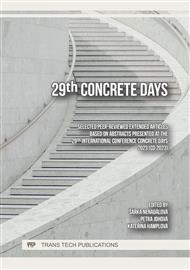p.39
p.45
p.53
p.59
p.71
p.79
p.93
p.101
p.113
Dependence of a Steel-concrete-Steel Sandwich Structure Behavior under Pure In-Plane Shear Loading on the Reinforcement Ratio
Abstract:
This paper deals with failure modes of a steel-concrete-steel sandwich loaded by pure in-plane shear. Current research together with the developed models imply that increase of reinforcement ratio leads to decrease of ductility and possibly to change a failure mode from yielding of steel in tension to crushing of concrete in compression which results in brittle failure. In order to give a reader basic information about in-plane shear behavior of a steel-concrete-steel sandwich, an analytical model is introduced. Japanese experimental program that researched a behavior of SCS panels with reinforcement ratio 2.3%, 3.2% and 4.5% is also shown. In addition to the effect of changing the reinforcement ratio, the experimental program also investigated the effect of the transverse steel plate on the ductility of test panels with a degree of reinforcement of 3.2%. The next chapter describes the methodology used by the author to model the individual parts of the model, the loads, and especially the method of supporting the model. This is followed by the presentation of the results of the analysis on the calibration and extrapolation models. Finally, a discussion is conducted on the agreement of the analysis results on the calibration models with the Japanese experimental results, followed by an evaluation of the analysis results on the extrapolation models. According to the results on the extrapolation models the critical degree of reinforcement at which a change in the failure mode of the structure occurs under in-plane shear loading is around 13%.
Info:
Periodical:
Pages:
71-78
Citation:
Online since:
March 2024
Authors:
Price:
Сopyright:
© 2024 Trans Tech Publications Ltd. All Rights Reserved
Share:
Citation:



